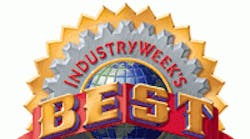Thomas & Betts Corp.: IW Best Plants Profile 2005
Thomas & Betts Corp., Athens, Tenn., Operations
Employees: 405, union, International Brotherhood of Electrical Workers, Local 175
Total square footage: 324,000
Primary products: Electrical outlet and conduit boxes, metal framing accessories, and plastic wiring duct
Start-up: 1965
Achievements: The Athens, Tenn., Operations earned Thomas & Betts' "Plant of the Year" and "Most Improved Plant" in 2003. Since fourth-quarter 2003, the facility has gone more than 1.4 million hours without a lost-time accident.
At 9:30 A.M., the 12-person management team at Thomas & Betts in Athens, Tenn., ritually walks through the plant. Just a few years ago, this group would have huddled in a conference room, reviewed problems, assigned blame and pushed solutions to the plant floor. Now they manage by what they see happening on the plant floor.
"You get a three-shift snapshot," says Mike Hammons, value-stream manager for boxes and covers. "Are we on target, and if we're not, what immediately needs to be done?" The plant produces more than
1 million units per day on more than 100 stamping presses and extrusion machines, and consumes nearly 200 tons of steel daily. Real-time resolution is real critical, but in the past it didn't always occur.
Plant Manager Herb Bradshaw says that five years ago he believed the Athens plant was among the company's best, but he also realized it wasn't near world-class, and told the team: "We are doing good things. We are making little incremental improvements. But we have to change the way we do business."
The Athens plant embarked on a five-year plan that has driven operations and financial improvements and set the companywide pace for Thomas & Betts. Management steeped itself in learning world-class practices and pegged its improvement approach on classic lean manufacturing. In roundtables, Bradshaw discussed this new competitive direction with the union workforce: lower inventories, more changeovers, flow of materials, cellular manufacturing and one-piece flow.
For example, "We had two months' worth of raw [material] and WIP [work-in-process inventory] in the building, and it was everywhere," recalls Bradshaw. "We probably had three months' worth of finished goods -- and bad service. We were working to forecast, and the forecasts were always wrong. Our response times were horrible. It could be 60 days for us responding to actual customer demand. Today our response time is hours. With our pull system, based upon degradation of finished-goods inventory to shipments from our main warehouses, we see [demand in] real-time."
Customer pull is executed in the plant using a loop cycle that designates the quantity and order of SKU production (imagine a wheel that takes 28 days for a revolution and is divided into uneven wedges of SKUs). The plant makes about 3,200 different SKUs; high-volume products may appear repeatedly on the wheel (i.e., small lots made every six or seven days), while low-volume products appear less frequently or skip a loop.
Value-stream managers are responsible for planning and scheduling materials as well as operations supervision, dual roles that allow them to quickly respond to demand and alter the loop if necessary. The need to alter the loop is infrequent, however, as in-stock percentage is about 98%. The plant currently does this with about 35 days of finished-goods inventory on hand, compared with more than 70 days in 2001 when in-stock percentages were below 80%. Additionally, in 2001 it would have taken up to 18 days to restock an item; today, it's about five days, of which two days are transit. "[The ability to respond] gets you more intimate with your customers, and that's the thing lean did for us in the very beginning," Bradshaw says.
In addition to the pull system, value-stream mapping and management walkthroughs, several other practices support Thomas & Betts' lean improvements:
Supplier management: The plant has reduced raw material suppliers from more than 300 to 104, and suppliers now are integrated into the plant's lean scheduling and learning its lean ways. "We were 'old-school' -- beat up the supplier and get the best price. That's not the case any more," Bradshaw says. More than 80% of inventory is managed by suppliers or delivered daily. The plant is shifting all material to daily delivery, and "happier" suppliers will be freed from consignments and able to improve their cash flow.
Improvement projects: The plant has undertaken 37 formal kaizen events since 2002. For three to five days, salary and union employees (and occasionally suppliers) together solve tough problems as well as learn about waste identification, 5S, mapping and standardization. Support staff, such as maintenance and welding, assist as necessary. Eighty percent of the workforce has been trained in "Lean 101," mapping and kaizen.
"The key was changing a 35-year-old production philosophy in this plant amid a stable environment, high seniority, high years of service," says Bradshaw.
"Just look at the numbers," advises Darrell Dumont, manufacturing engineering manager. "We're a 40-year-old plant, and we have equipment, some of which is older than 40-years-old. We're a union shop and a mature workforce, yet we can compete with anybody around. We can compete with China. We can compete with India. We're not afraid of those folks."
| IndustryWeek is now accepting nominations for the 2006 IW Best Plants Program. |
"Change has been the only constant for the last four years," says Kim Miller, value stream manager, extrusion. And Thomas & Betts continues to change processes and streamline production, so much so that Bradshaw resists allowing the workforce to paint lines on the floors. By end of year, lean efforts will have cumulatively freed up 130,000 square feet of manufacturing space in the plant, allowing it to accommodate more new business. "If you open it up, it will come," Bradshaw says.




